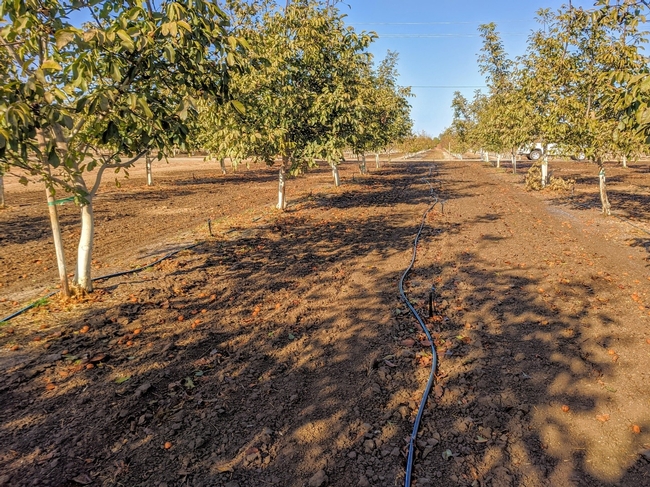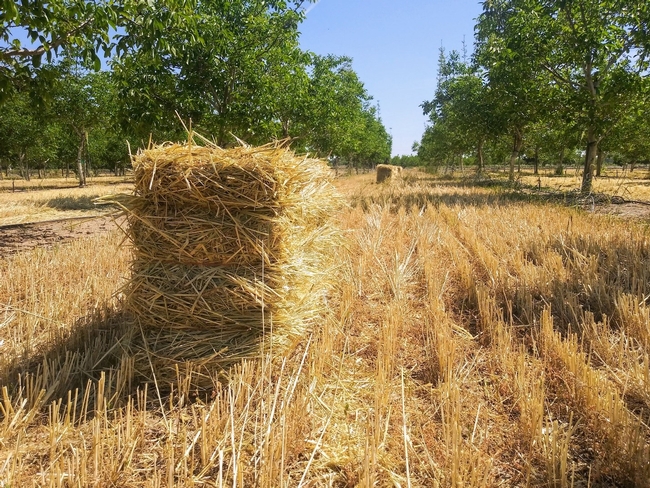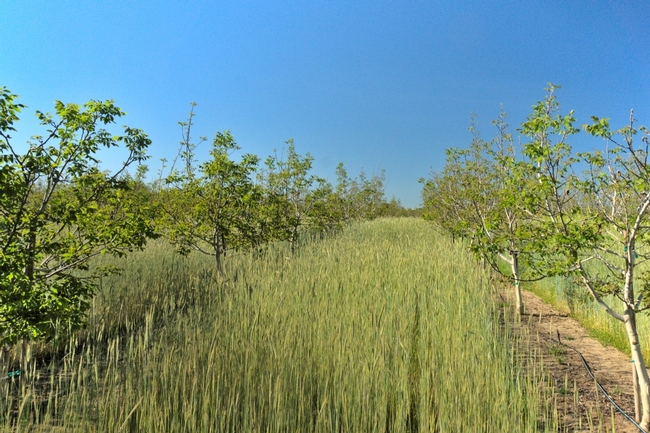Over the last few years, UC Davis Weed Science has been testing cover crops for weed suppression in nut orchards. The most recent project we've been working on has trialed several cover crop programs using cereal rye in walnut orchards. These cover crop programs represent a range of several management philosophies, from a basic, low-input program to a high-intensity forage intercrop. So far, we are finding that a variety of winter cover crop programs can provide some level of winter weed suppression, but cover crops are not (and may never be) a complete vegetation management solution for the orchard floor.
Weed scientists have been thinking a lot more about cover crops recently. Because of renewed concerns about herbicide-resistant weeds and, therefore, increased interest in IPM, we have been trying to understand how to replace unwanted weeds with desirable plants. Researchers in annual cropping systems have been leading this charge, even going so far as developing cover crop systems that use neither herbicides nor tillage.
In California, many recent cover crop discussions have focused on management goals other than weed suppression, especially in orchard systems. Research has examined the benefits and challenges of cover crops related to soil health, water management, insect pests, and other facets of the agroecosystem. If weed suppression is a specific management goal, more management recommendations are needed to make cover crops feasible in the unique environment of a California orchard.
A large part of this feasibility challenge is related to the logistical demands of adding an additional layer of crop management on top of an existing orchard system. Will the cover crop provide any benefit if it is simply planted in the orchard and left until spring? Will it pay to use other inputs on the cover crop, such as fertilizers, herbicides, or additional irrigation? We started an experiment to try to answer some of these questions.
We planted cereal rye into a walnut orchard in Davis, CA in November 2019 (photo 1). There were four different cover crop programs based around cereal rye, as well as a bare-floor treatment where the rye was sprayed out with herbicides. A basic cover crop program had 50 lbs/acre rye planted into the orchard alley and no other inputs. A boosted cover crop program had the same rye planting with some starter irrigation and a nitrogen topdress in the spring (photo 2). A multi-species cover crop program had additional mustard and legume species planted along with the rye cover crop. Finally, a forage crop program was planted with 100 lbs/acre rye that received starter irrigation, a postemergent application of carfentrazone, and fertilizer at planting and in the spring.
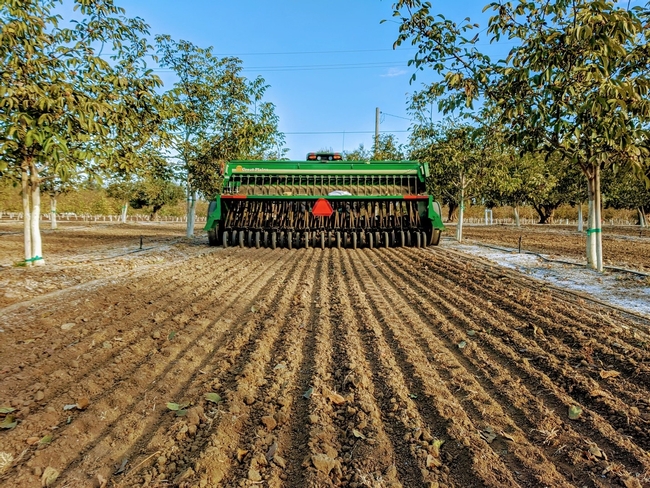
In April 2020, we harvested orchard floor vegetation from two 0.25 m2 quadrat samples within each cover crop treatment plot. The harvested samples were separated, so that we could measure what proportion of the sample's mass came from weeds compared to cover crops. Then, the cover crops were terminated by mowing with a flail mower, except for the forage treatment which was swathed, baled, and removed (photo 3). At the time of harvest, the cereal rye was post-anthesis and taller than 7' in spots (photo 4). Weed species present at this time predominantly included Italian ryegrass (Lolium multiflorum), hare barley (Hordeum murinum ssp. leporinum), whitestem filaree (Erodium moschatum), and California burclover (Medicago polymorpha). We also monitored the experiment after harvest to evaluate cover crop regrowth and the effects of cover crop residue on summer weed emergence, which included predominately field bindweed (Convolvulus arvensis), spotted spurge (Euphorbia maculata), yellow nutsedge (Cyperus esculentus), and bermudagrass (Cynodon dactylon) in this orchard.
All of the cover crop treatments reduced weed biomass when compared to the bare ground treatment. However, none of the cover crop treatments consistently reduced weed biomass more than any other treatment (table 1). While the two treatments receiving supplemental fertilizer and irrigation (i.e. the boosted cover crop and the forage crop) appear to have produced slightly higher cover crop biomass than the other two treatments, these differences weren't large enough to be considered significant. The forage crop treatment did demonstrate more cereal rye regrowth after termination than other treatments, but we are still evaluating the effects of each treatment's residual effects on summer weed emergence. While the cover crop does leave significant residue in the orchard initially, it seems to break down fairly quickly and evenly across the orchard floor (photo 5).
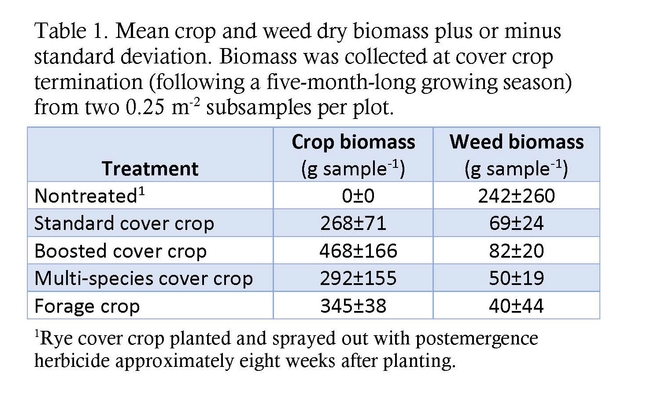
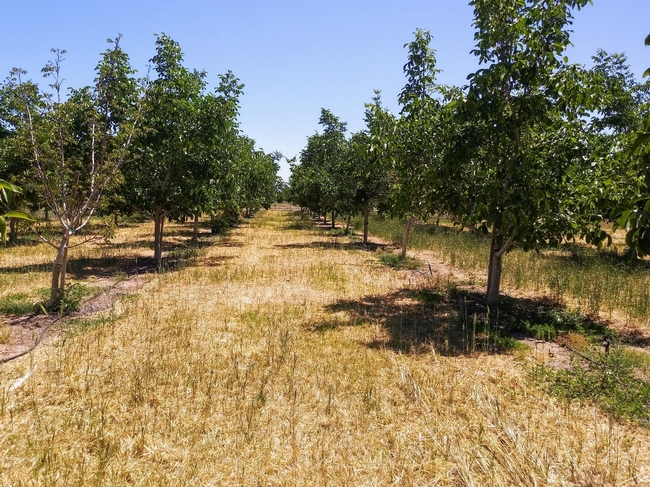
This experiment supports the idea that a weed-suppressing cover crop can be used to displace unwanted vegetation. While we understand that any cultivated cover crop can outcompete weeds for resources like light, water, and nutrients, we are still trying to draw conclusions about how management actions related to these resources affect competition between weeds and cover crops. Orchards are complex, ecological systems, and many relationships may exist between horticultural management, cover crops, and weeds.
Early cover crop establishment might be one management practice that does have a direct relationship with weed suppression, based on other cover crop studies, including some of our own research in almond orchards (see Almond Cover Crop website). Management practices that help a cover crop emerge, and access resources, ahead of weeds can help minimize the resources available for weeds to take. Think about the logistics of planting a winter cover crop early enough to get ahead of winter weed emergence. Timing, equipment availability, and other management goals are all important when planning for an orchard cover crop.
The first year of this study demonstrated that cover crops have some level of weed suppression across a variety of management systems but that impacts were not dramatic after only one season. However, cover cropping is a cultural practice that affects the whole orchard ecosystem. We expect that several consecutive years of cover cropping may lead to cumulative effects such as a reduced weed seed bank or different winter weed species in the plant community. We will be repeating this experiment beginning in early winter 2020. Contact Steve Haring (sharing@ucdavis.edu) if you are interested in becoming involved in this project or learning more!
Steve Haring is a graduate student in the Hanson Lab (Weed Science Program, Dept. of Plant Sciences) at UC Davis.
